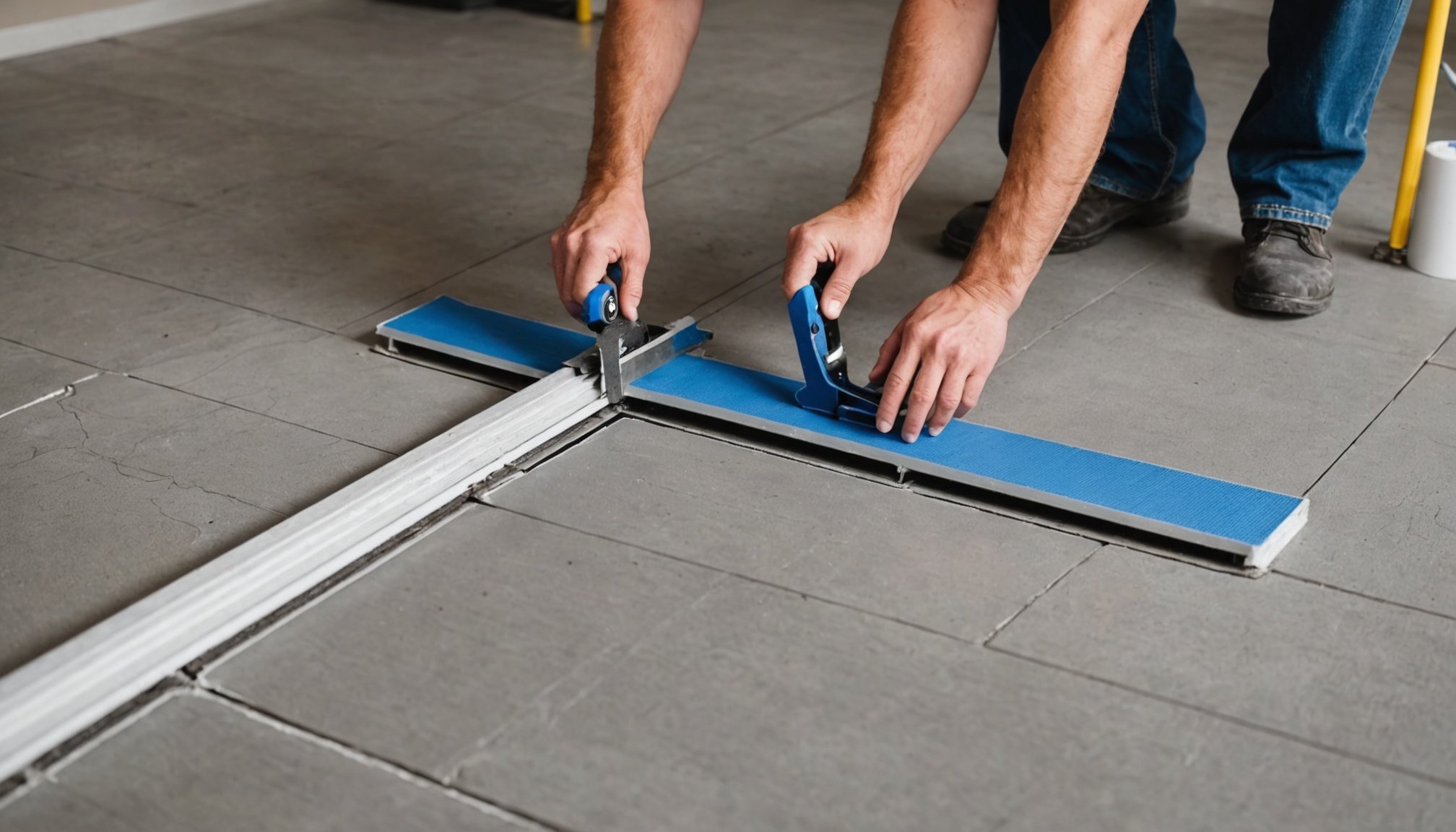Overview of Underfloor Heating in Concrete
Underfloor heating provides a seamless heating experience, especially when used with concrete floors. Concrete acts as an excellent heat conductor, allowing the warmth from the heating systems to spread uniformly. This enhances comfort while being energy-efficient.
There are two primary types: electric and hydronic systems. Electric systems use heated cables beneath the floor to radiate warmth, making them ideal for smaller areas or renovations due to their straightforward installation. On the other hand, hydronic systems use water-filled pipes and are better suited for larger spaces due to their cost-effectiveness in extensive installations.
Also to read : Illuminate your imagination: crafting your ideal home library bathed in natural light
Before embedding underfloor heating into concrete surfaces, several considerations are essential. Thermal insulation is crucial to prevent heat loss and optimise system efficiency. Additionally, evaluating subfloor conditions ensures a smooth installation process. It’s imperative to choose a system that aligns with the room’s size and intended use. Professional consultation can help determine the most suitable option for your needs, considering both upfront costs and long-term benefits. With the right planning and execution, underfloor heating can significantly enhance the functionality and comfort of your living spaces.
Budget-Friendly Installation Techniques
When considering a cost-effective installation, the choice of materials plays a significant role. Opt for materials like reclaimed wood or recycled metal, which can drastically reduce overall installation costs.
Have you seen this : Unveil the best soundproofing solutions for the ultimate home theater experience
DIY Methods for Installation
Adopting a DIY approach can further enhance savings. Here’s a simple guide to help you get started:
-
Plan and Measure: Before purchasing materials, ensure exact measurements to prevent waste and additional costs.
-
Gather Tools: Basic tools such as a hammer, drill, and screwdriver are often all you need for a successful installation.
-
Follow Instructions: Many products come with comprehensive guides. Following them precisely ensures a smoother installation process.
Tips for Sourcing Affordable Components
- Local Stores: Visit local hardware stores for bulk discounts.
- Online Marketplaces: Platforms like eBay often have competitive prices on components.
- Community Groups: Websites like Freecycle help connect with others who might be giving away what you need.
By exploring these savings strategies, not only can you reduce initial expenses, but you also gain valuable skills. Embrace these methods to transform installation projects into a rewarding DIY endeavour.
Essential Materials and Tools
When preparing for underfloor heating installation, having the right materials and tools is vital. It not only ensures longevity but also efficiency.
Types of Heating Mats and Pipes
Different types of heating mats and pipes are available, each suited for specific flooring types and room conditions. Electric heating mats are ideal for tile or stone floors, providing even heat distribution. Water-based systems, using pipes, are excellent for larger areas or rooms that require a connection to central heating.
Insulation and Underlayment Materials
Proper insulation is crucial to prevent heat loss and improve efficiency. Thermal boards and reflective insulation mats are commonly used. They act as a barrier, directing heat upwards towards the floor surface. Underlayment materials like foam can add an additional layer of protection and stability.
Tools Required for Installation
Having the correct installation materials and tools can make the job smooth and effective. Common tools include:
- A mixing drill for concrete preparation
- Pipe cutters for precise pipe fittings
- A notched trowel for applying adhesives evenly
Using quality brands can enhance the system’s durability and performance. Brands like Warmup and Nuheat are renowned for offering reliable products that provide excellent value in terms of efficiency and cost.
Detailed Installation Steps
Proper installation of underfloor heating begins with meticulous floor preparation. Start by ensuring the concrete surface is clean, dry, and free of debris. This crucial step in the installation guide prevents damage and optimises the system’s performance. Cracks or uneven areas should be addressed, as they can compromise the integrity of the underfloor heating setup.
Next, proceed with the layout of the heating elements. Carefully position the heating mats or wires according to the planned design. Use adhesive tapes or fixing strips to secure them in place, ensuring even distribution and avoiding overlapping, which can cause overheating. This step is integral to the installation guide, as a precise layout enhances the heating efficiency and prevents future issues.
Before covering the heating system with flooring material, it’s vital to conduct a thorough testing phase. Follow manufacturer instructions to connect the system to the electrical supply and measure its functionality. Verify the heating elements are operational and the thermostat responds correctly. Address any discrepancies before proceeding. Testing ensures the reliability of the underfloor heating setup, providing peace of mind that the system will function optimally once it is concealed beneath the final floor covering.
Potential Challenges and Solutions
Installing a product can sometimes be perplexing, especially if you’re new to the process. Identifying installation challenges is crucial for a smooth setup. One common issue is uneven surfaces. This can affect the stability or functionality of the product. To troubleshoot this, it is essential to ensure that the surface is clean and level. Using shims or adjustable feet can help mitigate this problem.
Another frequent challenge involves temperature inconsistencies, which may affect the product’s performance. It’s important to take into consideration the manufacturer’s recommendations regarding the operational temperature range. Placing the product in a shaded area or using thermal insulation can help maintain an optimal environment.
To avoid further common issues, always follow the manufacturer’s instructions. These guidelines are designed to guarantee compatibility and efficiency, reducing the likelihood of troubleshooting needs. If problems persist, consulting customer support or accessing online resources may provide additional assistance.
Remember that while installation can pose certain challenges, understanding potential issues and their solutions can lead to a successful setup.
Cost Comparisons and Budgeting Tips
Examining the cost analysis for different heating systems can significantly aid in financial planning. Understanding both upfront costs and potential long-term savings allows for smarter budgeting for installation.
Analysis of Total Costs for Various Systems
Different heating systems come with varying initial investment requirements. While traditional systems might be cheaper to install, sustainable options like geothermal or solar can mean higher upfront costs but have more potential for energy savings in the long run.
Hidden Costs to Consider
Hidden costs such as maintenance, repairs, and energy consumption must be included in the total financial plan. These can impact your budget unexpectedly, making it crucial to assess beyond the initial price tag.
Long-term Savings from Energy Efficiency
Energy-efficient systems offer considerable long-term savings, outweighing their initial expenditures. Though financing options might ease the initial financial burden, evaluating both the environmental benefits and potential utility cost reductions is essential. Breaking down the installation, operational, and maintenance costs helps to highlight these differences. Opting for energy-efficient solutions provides not only a sustainable choice but an economically wise one.
Energy Efficiency and Maintenance
Ensuring energy efficiency in underfloor heating systems is crucial for reducing costs and environmental impact. To maximise energy efficiency, utilise programmable thermostats. These devices automatically adjust temperature settings based on your schedule, ensuring optimal heating when needed and conserving energy during off-peak times. Additionally, consider insulating your home properly. Adequate insulation minimises heat loss, allowing your system to maintain warmth more efficiently.
Routine heating maintenance is essential for prolonging the system’s lifespan. Regularly check for leaks or any obstructions that might affect performance. It is also advisable to schedule professional inspections annually. These inspections can identify potential issues early, ensuring optimal operation and avoiding costly repairs.
Implementing eco-friendly solutions can significantly reduce energy consumption. Solar-powered heating systems or using sustainable materials for insulation are excellent choices. Furthermore, lowering your thermostat by just 1 degree can lead to significant energy savings over time.
Embracing these tips and practices not only enhances energy efficiency but also promotes a more sustainable approach to heating maintenance. By being proactive, you contribute to both cost savings and environmental protection.
Safety Precautions
When it comes to installing any equipment, safety guidelines are paramount. Following installation safety protocols ensures not only your protection but also the optimal performance of the equipment. During the installation process, wearing protective gear such as gloves and goggles can prevent injuries. It’s crucial to read and understand the manufacturer’s instructions beforehand.
Risk prevention is key when dealing with electrical installations. One common risk is the potential for electrical shocks or fires. To mitigate these risks, make sure to turn off the power supply before starting the installation. Additionally, do not overload circuits to avoid overheating.
Adhering to local building codes is of utmost importance. These codes ensure that the installation complies with safety standards and regulations. Non-compliance can result in penalties and void warranties. Moreover, they are designed to protect the user, reducing the chance of accidents.
In summary, implementing these precautions not only guarantees safety but also enhances the reliability and efficiency of the equipment. By following these measures, you significantly reduce the chances of mishaps and ensure a successful installation.











